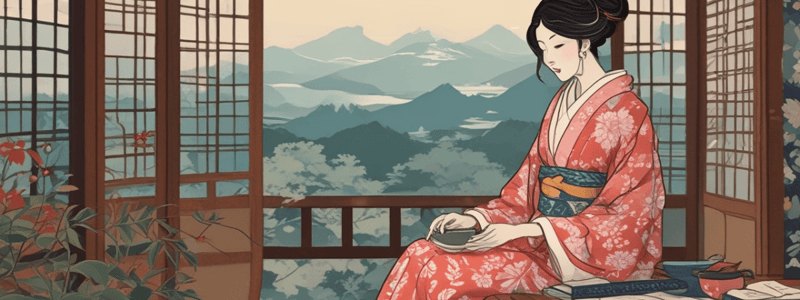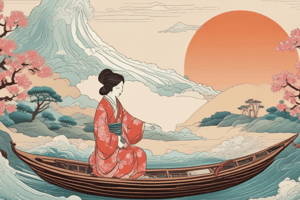Podcast
Questions and Answers
What is the primary focus of the last part of this module?
What is the primary focus of the last part of this module?
- The influence of patriarchal power on Japanese society
- The predicament of Japanese women in the field of crafts in the modern period (correct)
- The difference in the number of female artists between Japan and Western Europe
- The life story of a female artist who migrated to Brazil
Why did Japan historically have fewer female artists compared to Western Europe?
Why did Japan historically have fewer female artists compared to Western Europe?
- Due to the cultural differences between Japan and Western Europe
- Due to the lack of artistic education for women
- Because of the pervasive influence of patriarchal power in Japanese society (correct)
- Because of the limited job opportunities for women in Japan
What was the system of 'ie' or family foundation based on?
What was the system of 'ie' or family foundation based on?
- Patriarchal system, where authority was inherited from father to son (correct)
- Egalitarian distribution of power among family members
- Maternal love and care
- Maternal inheritance
How did Shintoism view women?
How did Shintoism view women?
What was the consequence of the patriarchal system on women's roles in Japan?
What was the consequence of the patriarchal system on women's roles in Japan?
What was the position of women in the craft workshop in Japan's history?
What was the position of women in the craft workshop in Japan's history?
What is the time period depicted in the movie Ugetsu Monogatari?
What is the time period depicted in the movie Ugetsu Monogatari?
What is the occupation of the couple in the movie Ugetsu Monogatari?
What is the occupation of the couple in the movie Ugetsu Monogatari?
What is the name of the tea school that Fujiko Kobori inherited as the 17th generation?
What is the name of the tea school that Fujiko Kobori inherited as the 17th generation?
According to art historian Midori Yoshimoto, what was still present in the Japanese art world in the 1960s and 1970s?
According to art historian Midori Yoshimoto, what was still present in the Japanese art world in the 1960s and 1970s?
How many women were nominated as Living National Treasures by the Japanese Ministry of Education, Culture, Sports, Science, and Technology in 2019?
How many women were nominated as Living National Treasures by the Japanese Ministry of Education, Culture, Sports, Science, and Technology in 2019?
What type of ceramic art objects allowed for the diversification of the field and opened up space for women artists?
What type of ceramic art objects allowed for the diversification of the field and opened up space for women artists?
What was the name of the first circle of Japanese women ceramic artists founded in 1957?
What was the name of the first circle of Japanese women ceramic artists founded in 1957?
Who was the founder of the Joryu Togei Association?
Who was the founder of the Joryu Togei Association?
Who was Asuka Tsuboi's mentor?
Who was Asuka Tsuboi's mentor?
What type of tasks were women limited to in the 1950s according to Asuka Tsuboi?
What type of tasks were women limited to in the 1950s according to Asuka Tsuboi?
What was the goal of the Joryu Togei Association?
What was the goal of the Joryu Togei Association?
What type of ceramic forms were mostly created by members of the Joryu Togei Association?
What type of ceramic forms were mostly created by members of the Joryu Togei Association?
What was one of the tasks that women may have performed in pottery production during the period mentioned?
What was one of the tasks that women may have performed in pottery production during the period mentioned?
What is the name of the style of painting depicted in the illustration?
What is the name of the style of painting depicted in the illustration?
During which period did women enjoy an unusual degree of autonomy in Japan?
During which period did women enjoy an unusual degree of autonomy in Japan?
Who was a famous poet, potter, and calligrapher mentioned in the passage?
Who was a famous poet, potter, and calligrapher mentioned in the passage?
What was the ideal promoted by the Japanese government in the early 20th century?
What was the ideal promoted by the Japanese government in the early 20th century?
What was a result of the Meiji Restoration of 1868?
What was a result of the Meiji Restoration of 1868?
When did women gain the right to vote in Japan?
When did women gain the right to vote in Japan?
What was a popular pursuit for women from the 1950s onwards?
What was a popular pursuit for women from the 1950s onwards?
Who was the first and only woman to inherit the title of iemoto in the Sogetsu school of ikebana?
Who was the first and only woman to inherit the title of iemoto in the Sogetsu school of ikebana?
What percentage of tea ceremony practitioners are women today?
What percentage of tea ceremony practitioners are women today?
What was the name of the daughter of famous ukiyo-e designer Katsushika Hokusai?
What was the name of the daughter of famous ukiyo-e designer Katsushika Hokusai?
What sparked Suzuki's decision to immigrate to Brazil?
What sparked Suzuki's decision to immigrate to Brazil?
What type of house did Suzuki and her husband rent in Brazil?
What type of house did Suzuki and her husband rent in Brazil?
What natural materials did Suzuki explore in Brazil?
What natural materials did Suzuki explore in Brazil?
What type of kiln did Suzuki build in Brazil?
What type of kiln did Suzuki build in Brazil?
How long does it take to fire ceramics in Suzuki's kiln?
How long does it take to fire ceramics in Suzuki's kiln?
Why did Suzuki's friend give her the noborigama kiln design?
Why did Suzuki's friend give her the noborigama kiln design?
Where did Suzuki hold her kiln opening ceremony?
Where did Suzuki hold her kiln opening ceremony?
What was the outcome of Suzuki's kiln opening ceremony?
What was the outcome of Suzuki's kiln opening ceremony?
Who built a noborigama kiln following Suzuki's design?
Who built a noborigama kiln following Suzuki's design?
How many noborigama kilns of its kind existed after Suzuki built hers?
How many noborigama kilns of its kind existed after Suzuki built hers?
What is the main inspiration behind Suzuki's Cosmos series?
What is the main inspiration behind Suzuki's Cosmos series?
What technique does Suzuki use to create surface decorations on her sculptures?
What technique does Suzuki use to create surface decorations on her sculptures?
What is the significance of the marks on the clay in Suzuki's work titled 'Campo'?
What is the significance of the marks on the clay in Suzuki's work titled 'Campo'?
What is the title of Suzuki's plate-like object featuring a net-like impression?
What is the title of Suzuki's plate-like object featuring a net-like impression?
Why did Suzuki want to be in the middle, according to her conversation?
Why did Suzuki want to be in the middle, according to her conversation?
What was Suzuki's reaction when her old potter friend said she was no longer 'Japanese'?
What was Suzuki's reaction when her old potter friend said she was no longer 'Japanese'?
What type of kiln does Suzuki use to fire her glazes?
What type of kiln does Suzuki use to fire her glazes?
What is the color achieved by using cobalt oxide in Suzuki's glazes?
What is the color achieved by using cobalt oxide in Suzuki's glazes?
What is the main reason why many women in Japan abandon their careers in ceramics after receiving major prizes or graduating from university?
What is the main reason why many women in Japan abandon their careers in ceramics after receiving major prizes or graduating from university?
What motivated Shoko Suzuki to become interested in ceramics?
What motivated Shoko Suzuki to become interested in ceramics?
Who did Shoko Suzuki finally find as an apprentice after being rejected by several masters?
Who did Shoko Suzuki finally find as an apprentice after being rejected by several masters?
What was the name of the annual exhibition where Shoko Suzuki participated as one of the few women?
What was the name of the annual exhibition where Shoko Suzuki participated as one of the few women?
Why did Shoko Suzuki and her colleagues erase the female suffix of their names?
Why did Shoko Suzuki and her colleagues erase the female suffix of their names?
What event inspired Shoko Suzuki to consider migrating to Brazil?
What event inspired Shoko Suzuki to consider migrating to Brazil?
What was Shoko Suzuki's occupation before becoming a potter?
What was Shoko Suzuki's occupation before becoming a potter?
Where did Shoko Suzuki establish her own pottery studio in 1957?
Where did Shoko Suzuki establish her own pottery studio in 1957?
What was the name of the neighborhood in São Paulo featured in the TV show that inspired Shoko Suzuki?
What was the name of the neighborhood in São Paulo featured in the TV show that inspired Shoko Suzuki?
What was Shoko Suzuki's husband's occupation?
What was Shoko Suzuki's husband's occupation?
Flashcards are hidden until you start studying
Study Notes
Women in Japanese Craftsmanship
- Historically, Japan had fewer female artists than Western Europe due to the patriarchal system and social expectations.
- Women's roles were limited to menial tasks or remained unnamed, and their achievements were often unrecognized.
Women in Japanese Art
- During the Heian period, aristocratic women enjoyed autonomy and played active roles in elite culture, producing literature and art.
- Women also served as professional painters at court and created images in the onna-e (women's paintings) style.
- They played important roles in politics, holding positions of power, including being empresses.
The Edo Period
- Despite their lower status, some women still managed to stand out as artists.
- Noble women of the high-ranking samurai class received training in calligraphy, poetry, and painting, referred to as the "three perfections."
- Notable women from this period include Ōtagaki Rengetsu, Ema Saikō, and Katsushika Ōi.
The Meiji Restoration
- With the abolition of the feudal system, new avenues for women's expression and education emerged.
- The ideal of ryōsai kenbo—"good wife, wise mother"—promoted women's roles primarily as homemakers and child bearers.
Post-WWII
- The feminist movement in Japan aimed to bring women into the public sphere, and women acquired the right to vote and enter public university education.
- Women began to enter art universities, and traditional arts like the tea ceremony and ikebana became popular pursuits for women.
Shoko Suzuki
- Born in 1929, Suzuki was a Japanese woman potter who migrated to Brazil to escape the constraints of her gender in the field of crafts in Japan.
- She was the first woman to be accepted as an apprentice by a Tokyo-based potter, Toko Karasugi, and began her career as an independent artist.
- She established her own pottery studio in suburban Tokyo and participated in the Totokai Pottery Association's annual exhibition, where she was the only woman among 60 members.
- In 1961, she migrated to Brazil with her husband, where she built a Japanese-style climbing kiln and began experimenting with local clays and glazes.
- Suzuki's work was featured in a solo exhibition at the São Paulo Museum of Modern Art, and she participated in an exhibition featuring contemporary Japanese Brazilian artists across various museums.
Studying That Suits You
Use AI to generate personalized quizzes and flashcards to suit your learning preferences.




